
The RBI has put 10 Public Sector Banks under Prompt Corrective Action (PCA) since April 2017.
Though the PCA framework has been in operation since December 2002, its guidelines were revised in April 2017.
The banks that have been put under the RBI scanner are Corporation Bank, Oriental Bank of Commerce, Dena Bank, Central Bank of India, IDBI Bank, Indian Overseas Bank, Bank of Maharashtra, UCO Bank. Bank of India (BoI) and United Bank.
What is Prompt Corrective Action?
The RBI regularly monitors the financial health of the banks.
If the financial health of a bank worsens beyond the limit set, the RBI puts the bank under a special watch category and imposes certain restrictions on it.
The bank has to follow a corrective action plan till it comes back to health. It has to make improvement in various areas.
The RBI assumes the power to push for changes in the bank considered necessary.
What is the criterion for initiating Prompt Corrective Action?
The RBI assesses and monitors the banks on the basis of the following key areas:
- Capital: The bank should have enough capital. Indicators to be tracked for capital are Capital adequacy ratio and/ or Common Equity Tier-1 ratio. Capital adequacy ratio (CAR) is the ratio of the capital to risk-weighted assets of the bank. It is also known as capital to risk-weighted assets ratio or CRAR. Common Equity Tier-1 ratio (CET-1 ) is the percentage of core equity capital to total risk-weighted assets.
- Asset quality: Indicators to be tracked is Non-Performing Assets (NPA). Net NPA ratio is calculated. It is the ratio of net NPAs to net advances. The bank should have lower NPAs
- Profitability: Indicator to be tracked is Return on Assets (ROA). It is the percentage of profit after tax to average total assets. The bank should have higher ROA
- Leverage: Indicator to be tracked is tier-1 leverage ratio. It is the percentage of the capital measure to the exposure measure. The capital measure is the Tier-1 capital or core capital. The exposure measure includes all assets in the balance sheet, derivatives exposure, securities financing transactions exposure and other off-balance sheet exposures. The bank should have a higher tier-1 leverage ratio.
Hence, the RBI will initiate PCA in case the bank hit the Trigger point in terms of Capital adequacy ratio. Common Equity Tier-1 ratio, Net NPA ratio, Return On Assets and tier-1 leverage ratio.
There are three levels of risk thresholds.
Risk threshold 1:
Capital
CRAR <10.25% but >=7.75% and/ or CET1 <6.75% but >= 5.125%
Asset quality
Net NPA ratio = 6.0% but <9.0%
Profitability
Negative ROA for two consecutive years
Leverage
leverage ratio <=4.0% but > = 3.5%
Risk threshold 2:
Capital
CAR <7.75% but >=6.25% and/ or CET1 <5.125% but >=3.625%
Asset quality
Net NPA ratio >=9.0% but < 12.0%
Profitability
Negative ROA for three consecutive years
Leverage
leverage ratio < 3.5%
Risk threshold level-3
Capital
CET1 <3.625%
Asset quality
Net NPA ratio >=12.0%
Profitability
Negative ROA for three consecutive years.
Leverage
Not specified.
Based on each trigger point, the banks have to follow a mandatory action plan. Apart from this, the RBI has discretionary action plans too.
Breach of ‘Risk Threshold 3’ of CET1 by a bank would identify a bank as a likely candidate for resolution through tools like amalgamation, reconstruction, winding up, etc.
What is the mandatory action plan to be followed by the bank?
1. On the breach of threshold 1:
- Restriction on dividend distribution/remittance of profits.
- Restriction on Promoters/owners/parent in the case of foreign banks to bring in the capital.
2. On the breach of threshold 2:
In addition to mandatory actions of Threshold 1,
- Restriction on branch expansion; domestic and/or overseas
- Higher provisions
3. On the breach of threshold 3:
In addition to mandatory actions of Threshold 1,
- Restriction on branch expansion; domestic and/or overseas
- Restriction on management compensation and directors’ fees, as applicable.
There are several discretionary corrective actions also that the RBI can take. You can read it in detail here: RBI Notification on PCA
That’s all.
You may also read:
The Twin Balance Sheet Problem Explained
Recapitalisation of Bank- Explained